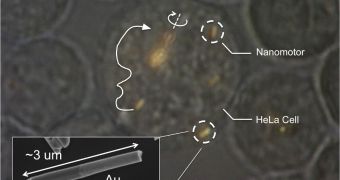A group of investigators in the United States announces the development of nanoscale motors that are able to penetrate cell walls, and mechanically-manipulate their insides in order to obtain a desirable result. Such a result could, for example, include annihilating cancer cells, the team explains.
Chemists and engineers at the Pennsylvania State University (Penn State) say that their nanomotors are made up of tiny, synthetic metal particles. These formations can be easily inserted inside living cells, and then propelled with ultrasonic waves. Since they are made of metal, the particles also respond to magnetic fields.
Scientists at Penn State hope that they will soon be able to use magnets to make the nanomotors slam through cellular components, and ram against cellular walls. This could, for instance, allow these very small structures to turn the interior of cancer cells to mush, in effect disassembling tumors.
The new investigation was led by Tom Mallouk, who holds an appointment as the Evan Pugh professor of materials chemistry and physics at Penn State. Details of the work were published in the February 10 International Edition of the esteemed journal Angewandte Chemie.
"As these nanomotors move around and bump into structures inside the cells, the live cells show internal mechanical responses that no one has seen before. This research is a vivid demonstration that it may be possible to use synthetic nanomotors to study cell biology in new ways,” Mallouk says.
“We might be able to use nanomotors to treat cancer and other diseases by mechanically manipulating cells from the inside. Nanomotors could perform intracellular surgery and deliver drugs noninvasively to living tissues,” the expert adds.
Mallouk carried out this investigation alongside researchers Wei Wang, Sixing Li, Suzanne Ahmed, and Tony Jun Huang, all of them from Penn State, and all co-authors of the new study. Also a part of the research was investigator Lamar Mair, who is based at the Weinberg Medical Physics, in Maryland.
The investigation was carried out on an immortal line of human cervical cancer cells called HeLa cells. The team says that they were able to steer the nanomotors using ultrasonic waves. Increased precision can be obtained by adding magnetic fields to the mix, the group adds.
In effect, the nanoscale structures acted like miniature eggbeaters inside the cancer cells, homogenizing their content to the point where no discernible organelles could be identified.
“One dream application of ours is Fantastic Voyage-style medicine, where nanomotors would cruise around inside the body, communicating with each other and performing various kinds of diagnoses and therapy. There are lots of applications for controlling particles on this small scale, and understanding how it works is what's driving us,” Mallouk concludes.

 14 DAY TRIAL //
14 DAY TRIAL //